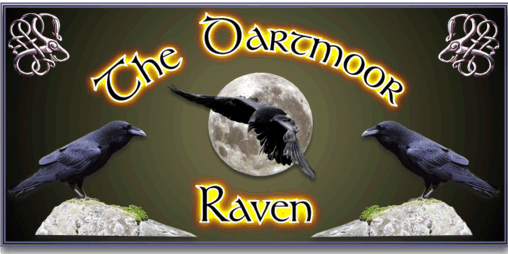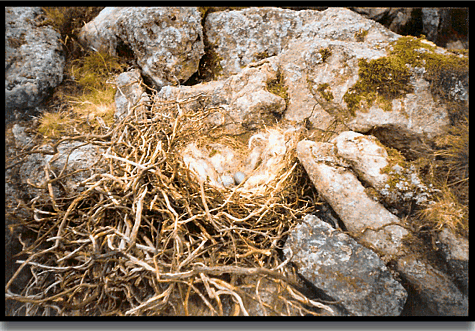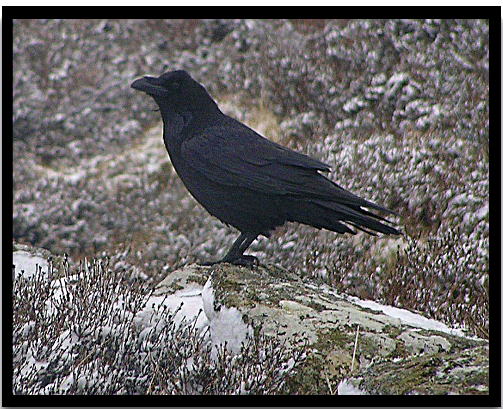
On many occasions when walking the moor the solitude and the silence has been broken by either a slow rhythmic ‘womping’ noise or a deep guttural ‘cronking’ both emanating from above and which announce the presence of a raven or a ‘sheep vulture’ as it is called on Dartmoor. Look up and there is the big black bird languidly flapping its way across the skies. There is no particular ‘hotspot’ to see them they just tend to turn up anywhere from the moorland fringes to deep in the fen.
Many see the bird as something that borders on evil which probably stems from its folklore traditions. There is the story of the ‘Blackingstone Ravens‘ and also of the ancient raven that stands guard over ‘Chaw Gully‘ both stories portray the bird as a harbinger of death. The raven has been associated with the Devil and is said to have the worst nature of all the birds. Old moorfolk believed that if a croaking raven flies over a house it is an omen of death or sickness. In a similar vein it was thought that if a raven flew around the chimney then anybody lying ill within the house would surely die. If anybody ever stole a raven’s egg then revenge would exacted by the death of a human baby. To see a raven resting on the church roof was taken to mean that within a week a corpse would be brought through the lych gate. The old tinners maintained that if ever a raven flew over the mine and its shadow passed over the shaft then a death would occur. So deeply was their belief in this that if it did happen they would refuse to enter the mine until all the machinery was checked.
In the myths and beliefs of the Arthurian Legends it was said that on his death, King Arthur turned into a raven. Ravens were also used to predict the weather, if one was seen preening itself this was taken to warn of approaching rain. If one was seen flying towards the sun then this bode well for a spell of hot weather. It was always supposed that the ravens birthday was Good Friday although why that day there is no record.
Everyone knows that tradition of the ravens of the Tower of London and that how if they ever desert the place then Britain will face a national disaster. However, this nearly happened in the early 1900’s as the colony was down to a single bird and so to avoid any catastrophe a local farmer from Dartmoor caught some young ravens in Sourton Quarry and sent them to the tower.
Although over the years ravens have suffered persecution from the farmer it is thought that the Dartmoor population is buoyant. They are early breeders and it is not unusual for them to have a clutch of eggs in late February. This does tend to leave them in a vulnerable situation in late winters as the exposed nests tend to fill up with snow. After fledging the ravens stay together in a family group until around autumn time when the juveniles will make their own way. It is at this time that groups of ravens are sometimes seen, in 1976 there was a report of 100 ravens roosting in trees down the Glazebrook Valley. Other gatherings have been noted throughout the moor at various times of the year. It is thought that ravens mate for life often re-using old nesting sites, which are usually located on ledges or crevices on the tor-tops or trees. I would not describe them as the neatest of house builders as their nests seem to be just thrown together. Quite often they are lined with wool or lichen and sometimes the nests are not always built in the safest of locations. I have seen one built on a stile and the one below I found built in the ruins of a blowing house up the Erme Valley.

Ravens will eat almost anything, from insects to grass and young birds to sickly lambs. If ever you find a recently dead animal on the moor the chances are the eyes have been pecked out by the ‘sheep vultures’. Back in 1930 there was an outcry in the local press regarding a ravens nest that was destroyed on Vixen Tor. To this end several letters were written in various local newspapers expressing their author’s anger and a fighting fund of £2 was raised to offer as a reward for finding the culprit. However, another letter appeared which read; “Sir, – Your correspondents are loud in their denunciation of the destruction of the ravens’ nest at Vixen Tor, but do not know that there is another side to the matter. Ravens and carrion crows are regards as pests by sheep-owners, for they will attack newly born lambs and pick their eyes out…. Sheep scratch themselves by rolling on their backs and get fixed like a beetle, upside down, and when relieved of their helpless position by their shepherd their eyes are often found picked out by ravens or crows. I daresay the “offender” against whom these ornithological enthusiasts have raised the fighting fund of £2 might be another sheep-owner like myself, and who has modestly rendered his public service under cover of a Dartmoor fog, and prefers to remain anonymous. I ride over Dartmoor more than any one else and save numbers of animals from the tortures of ravens and crows, and if some of those people who make much of the little they know could see what I see they would think more of suffering animals than a handful of dead ravens.” Western Morning News, May 7th, 1930.
Today was a snowy day and I managed to get out for a ‘trundle’, the moor was cold, crisp and ever better – deserted. Knowing I had started this page I was eager to get a picture of a raven, something I had never previously managed to do. All morning there were ravens womping and cronking in the watery skies but by the time I got the camera out they were but tiny black dots. At best I was just hoping for a fairly clear shot of one flying but no matter how hard I tried I couldn’t even manage that. But hey-ho, the walk and the snow more than compensated for that. Then, when I was about 500 yards from the car I spotted a pair of ravens flying towards me and provided they did not change course I should have been able to get a picture as they flew overhead. Alas, guess who had the wrong setting on the camera, the air went blue and the snow melted. But then, much to my astonishment, one of them alighted on a rock about 200 yards away, this time the camera was ready and I got a picture. I looked up and the bird was still sat on its rock so I walked a bit closer and took another shot, still the bird did not move and so I got nearer. Click, still the raven sat there, get closer, click, the bird was still there, it was as if it was saying come as close as you like – so I did until it finally had enough of posing and womped off up into the sky. The photo below shows how close the raven let me get and this was not taken on full zoom, never, ever have I managed to get this close. This will sound totally ridiculous, but it was as if the bird knew I badly needed a picture for this page and kindly obliged…?

As testament to their place on Dartmoor there are several place-names which use the ‘raven’ element. There is the Raven Buttress, four different Raven Rocks, three various Raven tors, and a Raven’s Tower.
 Legendary Dartmoor The many aspects past and present of Dartmoor
Legendary Dartmoor The many aspects past and present of Dartmoor

Hi back in march i was just cycleing out of burrator reservoir on my back home to horrabridge i happene’d to see a large black bird which i now know was a raven ? but how do they differ from the ones that are in the london tower .thank you phill .
Hi Phil, I am not sure as the Dartmoor ravens would differ from the 8 at the Tower of London, apparently those there today were all bred in Somerset. The only difference would be the tower birds have one wing clipped to stop them flying away.